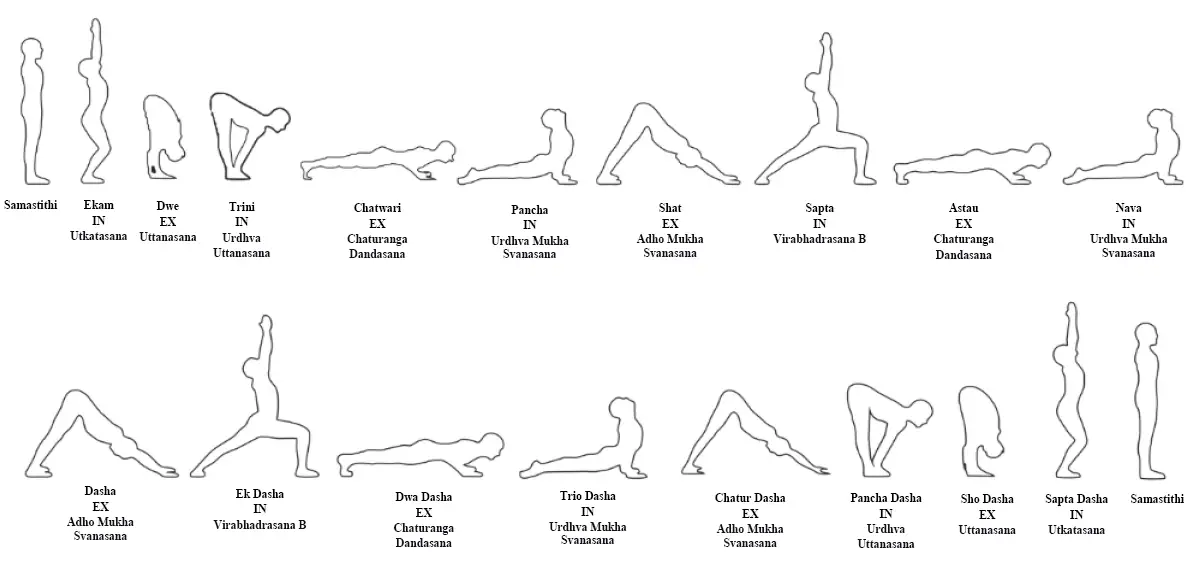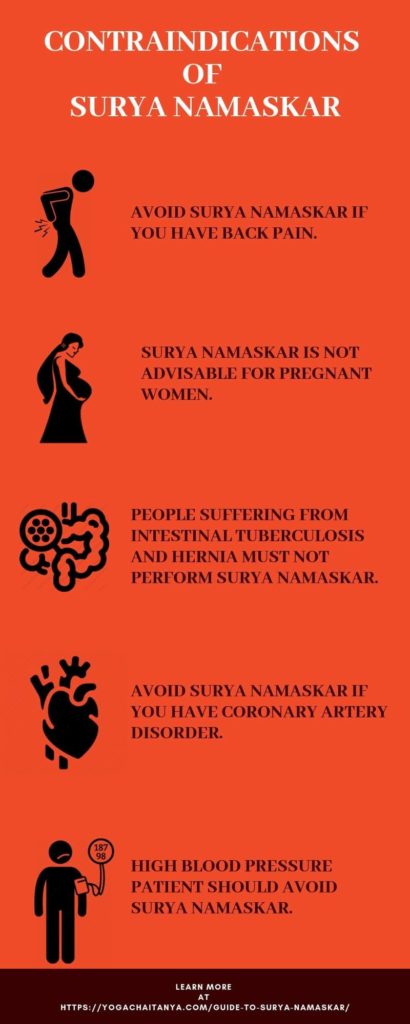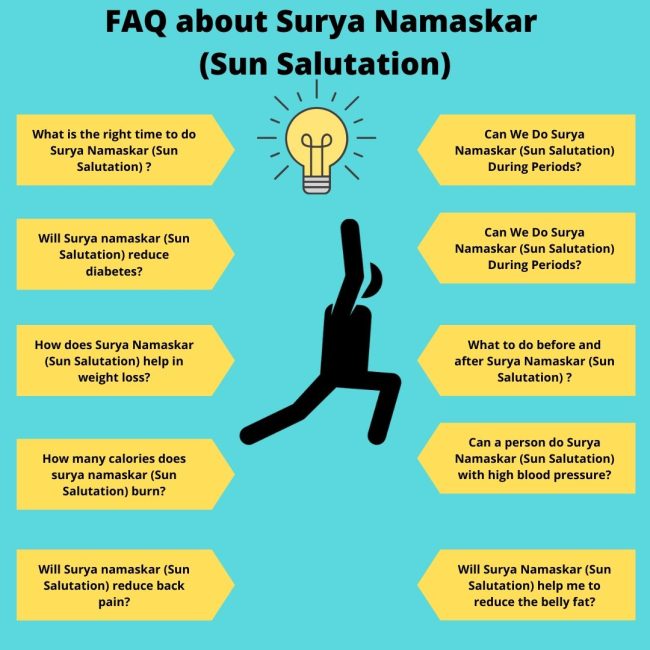Ultimate Guide for Surya Namaskar (Sun Salutation)
-
Written By: Sukhvinder Singh (Chaitanya)
- Published On:
- Last Updated: December 5, 2024
This is the most comprehensive guide to surya namaskar ever. In this guide you will learn everything you need to know about practice and implementation of surya namaskar (Sun Salutation) in daily life.
As a beginner or an advanced yoga practitioner, you may have questions or difficulties in practicing Surya Namaskar (Sun Salutation). This ultimate guide to Surya Namaskar (Sun Salutation) will provide you in-depth knowledge of the topic.
This is the most complete guide on the internet.
Let’s dive right in…
Table of Contents
What is Surya Namaskar (Sun Salutation)?
The Sanskrit meaning of Surya is sun and namaskar means ‘salutations’. As per Yogic tradition, the sun represents Pingala Nadi (Surya Nadi). Thus, Pingala Nadi is the pranic channel which carries the vital, life-giving force.
Regular practice of Surya Namaskar (Sun Salutation) regulates Pingala Nadi. Thus, regulation of Pingala Nadi leads to a balance in the energy system at mental and physical levels.
Surya Namaskar (Sun Salutation) is an effective way of warm up and stretching. Further, it also massages and tones all the joints, muscles and internal organs of the body.
Scientific Research on Surya Namaskar (Sun Salutation)
Many research and studies are done to study the effects and benefits of Surya Namaskar, some of these research studies are shared here:
The International Journal of Yoga and Allied Sciences published a study on the Effect of Surya Namaskar on Emotional Maturity and Psychological Wellbeing. This research study was conducted with 30 students aging 18-24 years.The sample was taken through accidental sampling. These students practiced Surya Namaskar regularly for 60 days.
This study states that the practice of Surya Namaskar is highly effective on the levels of Emotional Maturity and Psychological Well-Being.
Another study published by Research Gate “Effects of Surya Namaskar on Sustained Attention in School Children” claims that Surya Namaskar practice improves general health and fitness. It improves pulmonary, cardiovascular function.
Journal of Bodyworks & Movement Therapies published a study “Acute effects of Surya Namaskar on the cardiovascular & metabolic system.”
Six healthy Asian Indian men and women (18–22 years) trained in Surya Namaskar participated in the research study. Heart rate monitor and the Oxycon Mobile Metabolic System were used to measure heart rate and oxygen consumption.
This research study claims that the regular practice of Surya Namaskar may maintain or improve cardiorespiratory fitness, as well as promote weight management.
How many types of Surya namaskar (Sun Salutation) are there?
Different styles of yoga have their version of Surya namaskar ( Sun Salutation). However, the following styles of Surya namaskar are commonly practiced:
- Classical Hatha Yoga style Surya namaskar.
- Ashtanga Vinyasa Yoga style Surya namaskar A & B.
- Sivananda Yoga style Surya namaskar.
- Vinyasa Yoga style Surya namaskar.
I will cover classical hatha yoga style and ashtanga vinyasa style Surya Namaskar in this post.
Traditional Hatha Yoga Surya Namaskar (Sun Salutation)
Classical hatha yoga Surya Namaskar (Sun Salutation) is the traditional version of Surya namaskar. It is found in various ancient books and hatha yoga pradipika. It is one of the most commonly practiced styles of Surya namaskar(Sun Salutation).
12 Poses of Surya Namaskar (Sun Salutation) with Instructions and Explanation
1) Pranamasana (Prayer pose)
Stand straight with toes pointing forward, feet parallel below the hips. Roll your shoulders back to open your chest. Then, bring your chin parallel to the floor, gaze the point in front of you.
Inhale & Exhale: Join your hands in namaskar mudra in front of your heart center.
2) Hasta Utthanasana (Raised arms pose)
Inhale: Stretch your arms up over your head, and then arch back.
Engage your knees. Then, make sure your head is in line with your arms.
3) Padahastasana (Hand to foot pose)
Exhale: Bend forward from your pelvis keeping your back straight. Then, place your hands on either side of your feet, and drop your head.
Engage your knees. Then, make sure your fingers of hand and feet are in one line.
4) Ashwa Sanchalanasana (Equestrian pose)
Inhale: Without moving your hands, move your right leg back as far back as possible.
Then, make sure your right knee is on the ground, the foot is flat, the hip is down, chin up and chest open.
Left knee and left heel should in one line (Then, ensure that the knee does not travel out beyond the heel)
5) Parvatasana (Mountain Pose)
Exhale: Tuck the right foot & then move the left foot back. After that, lift your hips up into inverted V.
Make sure your hips are up, then engage your knees. Heels trying to touch the floor, shoulder blade pressed, head in line with the hands.
6) Ashtanga Namaskar (Salute with Eight parts)
Hold the breath: Drop the knees down keeping hips up. After that, bring the chest and chin down.
Then, make sure to keep your elbows inward towards the body.
7) Bhujangasana (Cobra Pose)
Inhale: Slide the chest forward and then lift your torso to arch back.
Then, make sure your feet are flat to protect the lower back and elbows are inward towards the body.
8) Parvatasana (Mountain Pose)
Exhale: Tuck both the toes of the foot and then lift your hips up into inverted V.
9) Ashwa Sanchalanasana (Equestrian pose)
Inhale: Bring the right foot forward between the hands so that fingers & toes are in one line.
Then, make sure your left knee is on the ground, the foot is flat, the hip is down, chin up and chest open.
Right knee and right heel should in one line (Then, ensure that the knee does not travel out beyond the heel)
10) Padahastasana (Hand to foot pose)
Exhale: Without moving your hands, move your left foot forward next to the right foot. After that, bend forward and drop your head.
Engage your knees & then make sure your fingers of hand and feet are in one line.
11) Hasta Utthanasana (Raised arms pose)
Inhale: Stretch up and then arch back.
12) Pranamasana (Prayer pose)
Exhale: Bring your hands forward in namaskar mudra and relax.
Surya Namaskar Mantras with Meanings
1) Pranamasana (Prayer pose): “Om Mitraya Namaha”
Salutations to the friend of all.
2) Hasta Utthanasana (Raised arms pose): “Om Ravaye Namaha”
Salutations to the shining one.
3) Padahastasana (Hand to foot pose): “Om Suryaya Namaha”
Salutations to he who induces activity.
4) Ashwa Sanchalanasana (Equestrian pose): “Om Bhanave Namaha,”
Salutations to he who illumines.
5) Parvatasana (Mountain Pose): “Om Khagaya Namaha”
Salutations to he who moves quickly in the sky.
6) Ashtanga Namaskar (Salute with Eight parts): “Om Pushne Namaha”
Salutations to the giver of strength.
7) Bhujangasana( Cobra Pose): “Om Hiranya Garbhaya Namaha”
Salutations to the golden, cosmic self.
8) Parvatasana (Mountain Pose):” Om Marichaye Namaha”
Salutations to the Lord of the Dawn.
9) Ashwa Sanchalanasana (Equestrian pose): “Om Adityaya Namaha”
Salutations to the son of Aditi, the Cosmic Mother.
10) Padahastasana (Hand to foot pose): “Om Savitre Namaha”
Salutations to the Lord of Creation.
11) Hasta Utthanasana (Raised arms pose): “Om Arkaya Namaha”
Salutation to the one who is the best one we adore and worship.
12) Pranamasana (Prayer pose): “Om Bhaskaraya Namaha”
Salutations to masters who leads to enlightenment.
Ashtanga Vinyasa Yoga style Surya Namaskar A & B
Ashtanga Vinyasa Yoga was the creation of K. Pattabhi Jois during the 20th century. The style is highly energetic, incorporating synchronous breath with movements. Ashtanga Vinyasa Yoga has two types of Surya namaskar (Sun Salutation), ie Surya namaskar (Sun Salutation) A & B. Surya namaskar A has 9 posture and Surya Namaskar B has 17 postures.
Before beginning the Surya namaskar (Sun Salutation), come and stand on the front side of your mat in samasthiti.
Samasthiti is an equal standing position with:
- Big toes touching each other.
- Heels slightly apart so that feet are parallel.
- Feet engaged with weight evenly distributed on balls & heels of feet.
- Legs engaged, pull up the kneecaps.
- Tail bone tucked in.
- Abdomen engaged.
- Roll the shoulder to open the chest.
- Chin parallel to the floor, face relaxed.
Ashtanga Surya Namaskar-A
1) Ekam: Urdhva hastasana
Inhale raise your arm and place the palm together, gaze to the thumb.
2) Dwe: Uttanasana
Exhale bend forward from hips and place the hand on the floor, gaze to the nose.
3) Trini: Urdhva Uttanasana
Inhale head up and spine straight, gaze to the third eye.
4) Chatvari: Chaturanga Dandasana
Exhale Jump or step back into staff pose. Keep your elbows bend close to the body, toes tucked and Knees off the floor, gaze to the nose.
5) Pancha: Urdhva Mukha Svanasana
Inhale roll your toes followed by shoulders to open the chest and arm straight, gaze to the sky.
6) Sat: Adho Mukha Svanasana
Exhale raise your hips and bring the shoulders down and gaze to the navel, hold the posture for 5 deep breaths.
7) Sapta: Urdhva Uttanasana
Inhale jump or step forward with spine straight & head up, gaze to the third eye. (Same as step 3)
8) Astau: Uttanasana
Exhale bend forward and place the hand on the floor, gaze to the nose. (Same as step 2)
9) Nava: Urdhva Hastasana
Inhale come all the way up, arms straight and place the palm together, gaze to the thumb. (Same as step 1)
Exhale back to Samasthiti.

Ashtanga Surya Namaskar-B
1) Ekam: Utkatasana
Inhale bend your knees and raise your arm and place the palm together, gaze to the thumb.
2) Dwe: Uttanasana
Exhale bend forward from hips and place the hand on the floor, gaze to the nose.
3) Trini: Urdhva Uttanasana
Inhale head up and spine straight, gaze to the third eye.
4) Chatvari: Chaturanga Dandasana
Exhale Jump or step back into staff pose. Keep your elbows bend close to the body, toes tucked and Knees off the floor, gaze to the nose.
5) Pancha: Urdhva Mukha Svanasana
Inhale roll your toes followed by shoulders to open the chest and arm straight, gaze to the sky.
6) Sat: Adho Mukha Svanasana
Exhale raise your hips and bring the shoulders down and gaze to the navel.
7) Sapta: Virabhadrasana ( Right side)
Inhale turn your left foot out at 45 deg and move your right leg between your hand. Further, bend the right knee over the right ankle, raise your arm and place the palm together, gaze to the thumb.
8) Astau: Chaturanga Dandasana
Exhale move into staff pose. Keep your elbows bend close to the body, toes tucked and Knees off the floor, gaze to the nose. (Same as step 4)
9) Nava: Urdhva Mukha Svanasana
Inhale roll your toes followed by shoulders to open the chest and arm straight, gaze to the sky. (Same as step 5)
10) Dasa: Adho Mukha Svanasana
Exhale raise your hips and bring the shoulders down and gaze to the navel. (Same as step 6)
11) Ekadasa: Virabhadrasana (Left side)
Inhale turn your right foot out at 45 deg and move your left leg between your hands. Further, bend the left knee over the left ankle, raise your arm and place the palm together, gaze to the thumb.
12) Dvadasa: Chaturanga Dandasana
Exhale move into staff pose. Keep your elbows bend close to the body, toes tucked and Knees off the floor, gaze to the nose. (Same as step 4)
13) Trayodasha: Urdhva Mukha Svanasana
Inhale roll your toes followed by shoulders to open the chest and arm straight, gaze to the sky. (Same as step 5)
14) Chaturdasha: Adho Mukha Svanasana
Exhale raise your hips and bring the shoulders down and gaze to the navel, hold the posture for 5 deep breaths.
15) Panchadasha: Urdhva Uttanasana
Inhale jump or step forward with spine straight & head up, gaze to the third eye. (Same as step 3)
16) Shodasha: Uttanasana
Exhale bend forward and place the hand on the floor, gaze to the nose. (Same as step 2)
17) Saptadasha: Utkatasana
Inhale bend your knees and raise your arm and place the palm together, gaze to the thumb. (Same as step 1)
Exhale back to Samasthiti.

What are the benefits of Surya Namaskar (Sun Salutation) ?
- Increases Physical, mental and spiritual strength.
- Surya Namaskar is a perfect warm-up exercise.
- It improves blood circulation.
- The practice of Surya Namaskar stretches and compress the abdominal region. Hence it is helpful in toning of the digestive system.
- Increases flexibility and fitness of the body. Further, it releases stiffness of joints and muscles.
- Regular practice of Surya Namaskar cures skin troubles. Thus, the face of practitioner glows like the sun.
- Cures complications in the vertebral column by stretching & bending of the spinal column.
- Surya Namaskar balances the metabolic rate.
- Surya Namaskar steps up the cardiac activity, increases respiration rate. So, it’s good for the lungs & heart.
- The practice of Surya Namaskar oxygenates the lungs. Thus it creates a detoxifying effect.
- Surya Namaskar stimulates the nervous system, improving eyesight. Further, it improves memory power, focus, and concentration.
- The practice of Surya Namaskar massages the abdominal organs, stomach, liver, spleen, & intestines. Hence helpful in the cure of constipation.
- Stimulates the lymphatic system thus, increase the immunity of the body.

Balance your dynamic, Yang energy the “Shiva” with Yin the “Shakti.” Join Yin Yoga Teacher Training in India. Learn the to teach Yin yoga with confidence. Learn Yinyasa sequences (Yin + Vinyasa), Dragon Surya namaskar.
Enroll in our yin yoga training in India, which offers more than just a certificate. Yoga Chaitanya’s Internationally Recognized Yoga Certification courses opens up opportunities for career and self-growth. Learn the skills and art of teaching yoga with confidence from experienced yoga teachers. Deepen your practice, Book Now!
Start your Yoga Journey to Transform your Life !
Who cannot practice Surya Namaskar (Sun Salutation) ?
Contraindications of Surya Namaskar (Sun Salutation)
- Avoid Surya Namaskar if you have back pain.
- Surya Namaskar is not advisable for pregnant women. since it creates pressure on the back & abdominal region.
- People suffering from intestinal tuberculosis and hernia must not perform Surya Namaskar. Hence, it is better to consult your doctor if you suffer from any other kind of ailment.
- Avoid Surya namaskar if you have coronary artery disorder.
- High blood pressure, arthritis slip disc, a sciatica patient should avoid Surya Namaskar.

Frequently Asked Questions about Surya Namaskar (Sun Salutation)
What is the right time to do Surya Namaskar or Sun Salutation?
You can practice Surya Namaskar in the morning and evening. The best time for practice is in the morning at sunrise and sunset in the evening.
Where to do Surya Namaskar or Sun Salutation?
The best place to practice Surya Namaskar or Sun Salutation is in the outdoors i.e. close to nature, facing the sun. You can also practice it inside a room, hall, or studio. Make sure the indoor premises have proper ventilation. But do practice it under the AC ( air conditioner)
What are the right techniques and benefits of doing Surya Namaskar (yoga)?
Incorporate the following elements in the practice to do Surya Namaskar correctly:
- Correct Posture alignment.
- Synchronous movement of breath and body.
- Awareness of body, breath, feelings, and thoughts.
For Instruction and Benefits of Surya Namaskar refer this article.
Can I do Surya Namaskar or Sun Salutation at night?
No, it is not recommended to practice Surya Namaskar late in the night. It will increase & trigger the energies of the body, which will make sleeping difficult at night. So, the Best time to practice Surya Namaskar is morning and evening on an empty stomach.
How many rounds of Surya Namaskar or Sun Salutation for beginners?
As a Beginner, you should practice 4-6 rounds of Surya Namaskar. But, then you can increase the limit and pace as per your comfort level.
Is Surya Namaskar or Sun Salutation is a cardio exercise?
Surya Namaskar is a complete exercise routine. Further, if you practice fast-paced Surya Namaskar it increases cardiac activity & respiratory rate. Hence we can say it is a cardio exercise.
Will Surya Namaskar or Sun Salutation reduce diabetes?
Yes, Surya Namaskar helps in reducing diabetes. Regular practices of Surya Namaskar tones and massage the abdominal organs. It helps to shed the excessive fat deposited on the internal digestive organs. Further, it helps to regulate blood sugar levels. Hence the Secretion of insulin and glucagon happens naturally.
How does Surya Namaskar or Sun Salutation help in weight loss?
Regular practice of Surya Namaskar tones the digestive system. It also balances the metabolic rate of the practitioner, hence helpful in weight loss. Increasing the number of repetitions and pace of Surya Namaskar or Sun Salutation will help in weight loss.
How many calories does Surya Namaskar or Sun Salutation burn?
Research claims that 1 round of Surya Namaskar burns 13.90 calories. The burning of calories depends on the weight/fat of the person and the intensity of the practice.
Will Surya Namaskar or Sun Salutation reduce back pain?
No, it is not recommended to practice Surya Namaskar if you have back pain. In the case of back pain, one should avoid forward-bending postures. On the other hand, we recommend you practice back-bending postures.
Can We Do Surya Namaskar or Sun Salutation During Periods?
Generally, it is not advised to perform any intense yoga asanas /Surya Namaskar or exercises during the first few days of menstruation. But it completely depends on a particular female and her body type. Further, it depends upon the amount of discomfort or pain, females experience during menstruation.
Is Surya Namaskar or Sun Salutation safe during pregnancy?
No, it is not recommended to practice Surya Namaskar during pregnancy. It can create extra pressure in the abdominal region. But, we recommend pregnancy yoga during this phase.
When can I start Surya Namaskar or Sun Salutation after delivery?
Generally, a woman can start practicing yoga after 6-8 weeks of the delivery. But, I advise you to consult a doctor before starting your yoga practice.
Start your practice with simple postures and gradually progress to more intense postures. After practicing simple postures for 3-4 weeks, you can start practicing complex yoga poses & sequences such as Surya Namaskar. But always listen to your body.
What to do before and after Surya Namaskar or Sun Salutation?
Practice some Sukshma Vyayama i.e Antirheumatic exercises or gentle warm-up stretches before doing Surya Namaskar.
One should do yoga asanas after doing several rounds of Surya Namaskar.
In case if you are a busy person then you can practice short meditation or yoga Nidra i.e. guided relaxation after the last round of Surya Namaskar.
Can a person do Surya Namaskar or Sun Salutation with high blood pressure?
Ideally, it is not recommended to practice Surya Namaskar or Sun Salutation if you have uncontrolled high blood pressure since it will increase the cardiac activity & respiratory rate.
But in case your high blood pressure is under control due to medication then you can practice the Surya Namaskar at a slow pace with some modification in postures.
You can replace the Parvatasana the Mountain Pose & Adho Mukha Svanasana i.e.Downward facing dog with Balasana i.e. child pose.
Will Surya Namaskar or Sun Salutation help me to reduce belly fat?
Yes, the regular practice of Surya Namaskar will help you to reduce belly fat. Surya Namaskar or Sun Salutation tones the muscles, and digestive system and increases the metabolic rate which in turn decreases the belly fat.
Can Surya Namaskar or Sun Salutation cure asthma?
Asthma is not a curable disease but, the regular practice of Surya Namaskar can act as a treatment for asthma. Surya Namaskar increases cardiopulmonary activity and generates heat in the body. This helps to reduce extra mucus in the airways. Further, it helps to reduce the production of phlegm in the lungs.
Can we practice Surya Namaskar or Sun Salutation for immunity?
Yes, Surya Namaskar increases the immunity of the body. The practice of Surya Namaskar increases blood circulation. Further, it stimulates the lymphatic system thereby increasing the circulation of lymphatic fluids in the body, thus it increases the immunity of the body.

Conclusion
With this Complete Guide to Surya Namaskar (Sun Salutation), you can energize your body and mind, burn toxins and improve your immunity. make sure you practice any type of Surya Namaskar on regularly to get its all benefits.
I hope you liked this post. Now I will like to hear from you. What did you think of today’s post? Or maybe you have a question about something you read.
Let me know by leaving a comment below.
Learn to teach different styles of Surya namaskar in depth to people of different body types, explore yoga in detail with our Multi style yoga teacher training courses in India.
Enroll in our yoga training india courses, which offers more than just a certificate. Yoga Chaitanya’s Internationally Recognized Yoga Certification courses opens up opportunities for career and self-growth. Learn the skills and art of teaching yoga with confidence from experienced yoga teachers. Deepen your practice, Book Now!
Start your Yoga Journey to Transform your Life !

About the Author: Sukhvinder Singh Chaitanya
Sukhvinder Singh (Chaitanya) is an experienced yoga teacher. (ERYT-500 & YACEP with 20,000+ hours of teaching experience) He is a master yoga teacher in Ashtanga Vinyasa Yoga, Vinyasa Flow, Hatha Yoga, Yin Yoga, Iyengar Yoga, Ayurveda & Laughter Yoga. He has been teaching yoga, laughter yoga & meditation all across the globe in teacher training programs, workshops & corporate sector for almost 10 years. He's the founder and director of the Yoga Chaitanya International Institute, a leading Yoga Teacher Training school in the world. He shares his expertise in his blogs and his YouTube Channels.

1 thought on “Ultimate Guide for Surya Namaskar (Sun Salutation)”
thanks for sharing the blog.